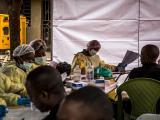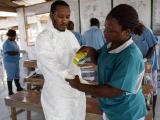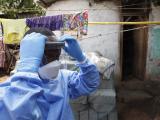Sep 28, 2011 (CIDRAP News) US government laboratories had 395 incidents that involved the potential release of select agents between 2003 and 2009, though only seven related infections were reported, according to a new National Research Council (NRC) report.
The accidents, including animal bites, needle sticks, and other mishaps, are mentioned briefly in an NRC report on the plans for a risk assessment for an Army biodefense lab to be built at Ft. Detrick in Frederick, Md.
"The Centers for Disease Control and Prevention (CDC) reports 395 cases of potential release events at national laboratories working with select agents," the report says.
"Seven LAIs [laboratory-acquired infections] were reported to CDC; four infections involved Brucella melitensis, two involved Francisella tularensis, and one involved an unspecified Coccidioides species," it continues. "CDC plans to publish an analysis of these events." The report does not list the outcomes of the infections.
F tularensis causes tularemia and is listed by the CDC as a Category A biological agent, meaning it can be easily disseminated or transmitted and can cause high mortality. Brucella species cause brucellosis and are classified as Category B agents, a less dangerous group.
The report mentions seven types of problems that involved potential releases, the most common of which was "loss of containment," with 196 cases. The second most frequent problem was spills. The others were:
- animal bites and scratches, 11 cases
- needle stick or sharps injuries, 46
- equipment mechanical failure, 23
- personal protective equipment failure, 12
- procedural issues, 30
The report does not identify any of the labs involved or detail which agents were potentially released in the various instances.
In response to a CIDRAP News query today, CDC spokesman Von Roebuck said he couldn't give more details but said that the agency plans to publish a report next spring on potential select-agent releases. He said the CDC for security reasons does not identify labs involved in select-agent research.
"When a potential select agent release occurs, CDC works with the entity to investigate to understand how the incident occurred and make recommendations to prevent the incident from reoccurring," Roebuck said via e-mail. "In some cases, the CDC investigation is provided to the HHS OIG [Department of Health and Human Services Office of Inspector General] for further action and possible penalties or fines."
He said the CDC provides an annual report to Congress on select agent incidents, adding, "CDC is currently analyzing data on potential select agent releases reported by the regulated community using APHIS/CDC Form 3 (Report of Theft, Loss, or Release of Select Agents and Toxins). This data is planned to be published by spring of 2012 in a peer-reviewed journal."
The potential select-agent releases are a sidelight in the NRC report, which deals with the Army's risk-assessment plan for the Medical Countermeasures Test and Evaluation (MCMT&E) facility at Ft. Detrick. Researchers at the facility will work to develop new vaccines and drugs for Category A agents, such as Ebola virus and Bacillus anthracis.
The Army had asked the NRC to review its plans for a site-specific risk assessment (SSRA) for the facility. The general verdict of the NRC committee that reviewed the plans is that "the methodology of the SSRA is not sufficiently robust to assist the Army in designing a facility that will reduce the risk from potential hazards from the facility's operations," the report states.
The document is the second of two letter reports by the NRC on the Army's risk assessment planning for the facility. In the first report, released in May, the council advised the Army to prepare a more comprehensive risk assessment than it was proposing.
In the new report, the NRC says the Army's plan "fails to consider the full range of potential occupational exposures" to dangerous pathogens. It cites the CDC data on potential releases in support of this assertion.
See also:
National Academies page with links to the NRC report on the risk assessment plan for the MCMT&E facility
May 2 CIDRAP News story about previous NRC report on the project



















